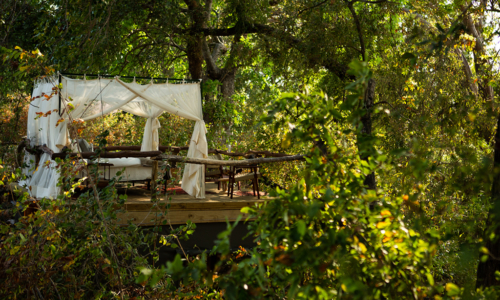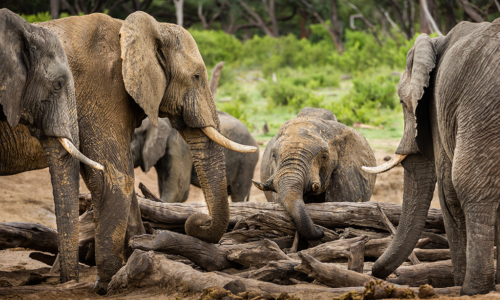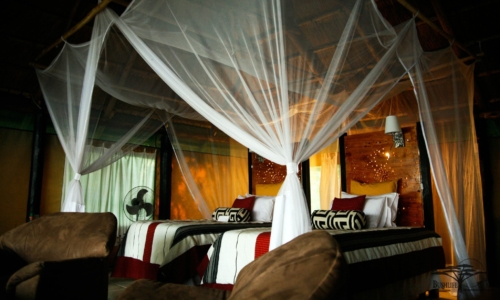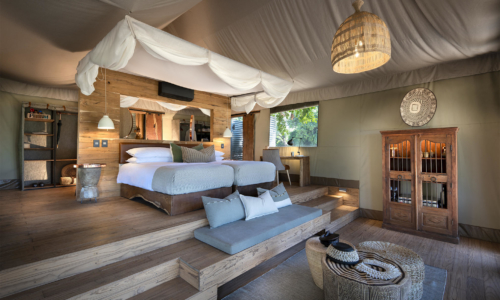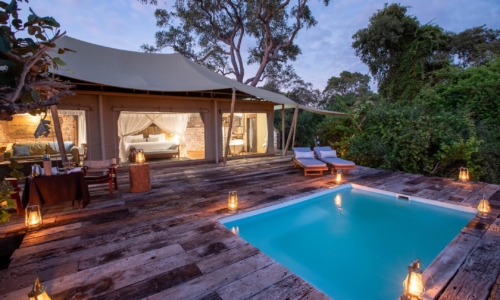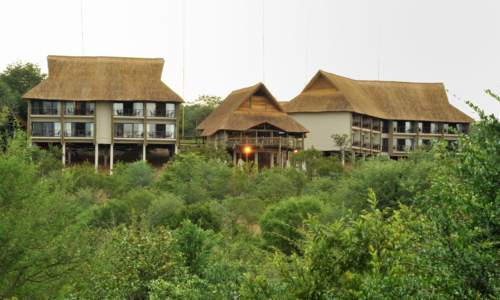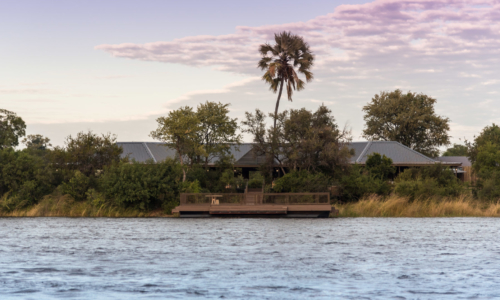Accommodations consist of four luxurious canvas tents on raised wooden floors, complete with beautiful furniture. The two Sail Tents come with gauze sliding doors, a glass wood-burner fireplace for the cold winter nights, and an overhead fan for the hot summer days. The en suite bathrooms feature flush toilets, both an indoor and outdoor shower, as well as a copper slipper-style bathtub. Due to a complete rebuild, the camp now has two family tents which use inter-leading walkways between the parents and children’s rooms, both of which come with their own bathroom.
The camp is located within Hwange National Park, Zimbabwe’s largest and most popular national park. It is located between Bulawayo and Victoria Falls and is most famous as a home to 30,000 elephants, although countless other animal species inhabit this rich panorama of acacia woodland and sands. The vegetation across the park vary hugely, ranging from the semi desert scrub on the edge of the Kalahari in the south, to forests, granite hills, and valleys of mopane woodlands in the north. There is an abundance of wildlife found in the park year-round including lion, buffalo, cheetah leopard, spotted hyena, cheetah, giraffe, sable, roan, blue wildebeest, impala, waterbuck and reedbuck.
Game drives are conducted in open Land Rovers by expert guides and trackers through Hwange. Morning walking safaris led by a knowledgeable guide are the best way to see the landscape in detail and view any smaller flora or fauna missed by the vehicles. Night drives discover the nocturnal world of lesser bush baby, spotted hyena, leopard, lion, caracal, porcupine, scrub hare, springhare, and even honey badger. Cultural visits travel to the local villages for a guided tour of the school, meeting the headman or headwoman, and enjoying cultural exchanges with the villagers. A bird watcher’s paradise, there are over 400 bird species in the park.
The camp overlooks a small waterhole where plenty of animals come for a drink. The main camp area houses a comfortable lounge area and dining room. The refreshing swimming pool enjoys its own views of the waterhole. At night, guests gather around the boma camp fire for a drink and chance to swap stories.


- Amalinda Lodge
- Bumi Hills Safari Lodge
- Changa Safari Camp
- Chikwenya
- Davison’s Camp
- Deteema Springs
- Ingwe Pan
- Kanga Camp
- Linkwasha Camp
- Little Makalolo
- Little Ruckomechi
- Little Vundu
- Matetsi Victoria Falls
- Mpala Jena Camp
- Nyamatusi Camp
- Old Drift Lodge
- Pamushana Lodge
- Ruckomechi Camp
- Sapi Explorers Camp
- Sapi Springs Camp
- Somalisa Acacia
- Somalisa Camp
- Somalisa Expeditions
- Tembo Plains
- The Elephant Camp
- The Hide
- Verney’s Camp
- Vundu Camp
- Zambezi Expeditions
- Amalinda Lodge
- Bumi Hills Safari Lodge
- Changa Safari Camp
- Chikwenya
- Davison’s Camp
- Deteema Springs
- Ingwe Pan
- Kanga Camp
- Linkwasha Camp
- Little Makalolo
- Little Ruckomechi
- Little Vundu
- Matetsi Victoria Falls
- Mpala Jena Camp
- Nyamatusi Camp
- Old Drift Lodge
- Pamushana Lodge
- Ruckomechi Camp
- Sapi Explorers Camp
- Sapi Springs Camp
- Somalisa Acacia
- Somalisa Camp
- Somalisa Expeditions
- Tembo Plains
- The Elephant Camp
- The Hide
- Verney’s Camp
- Vundu Camp
- Zambezi Expeditions

Accommodations consist of four luxurious canvas tents on raised wooden floors, complete with beautiful furniture. The two Sail Tents come with gauze sliding doors, a glass wood-burner fireplace for the cold winter nights, and an overhead fan for the hot summer days. The en suite bathrooms feature flush toilets, both an indoor and outdoor shower, as well as a copper slipper-style bathtub. Due to a complete rebuild, the camp now has two family tents which use inter-leading walkways between the parents and children’s rooms, both of which come with their own bathroom.
The camp is located within Hwange National Park, Zimbabwe’s largest and most popular national park. It is located between Bulawayo and Victoria Falls and is most famous as a home to 30,000 elephants, although countless other animal species inhabit this rich panorama of acacia woodland and sands. The vegetation across the park vary hugely, ranging from the semi desert scrub on the edge of the Kalahari in the south, to forests, granite hills, and valleys of mopane woodlands in the north. There is an abundance of wildlife found in the park year-round including lion, buffalo, cheetah leopard, spotted hyena, cheetah, giraffe, sable, roan, blue wildebeest, impala, waterbuck and reedbuck.
Game drives are conducted in open Land Rovers by expert guides and trackers through Hwange. Morning walking safaris led by a knowledgeable guide are the best way to see the landscape in detail and view any smaller flora or fauna missed by the vehicles. Night drives discover the nocturnal world of lesser bush baby, spotted hyena, leopard, lion, caracal, porcupine, scrub hare, springhare, and even honey badger. Cultural visits travel to the local villages for a guided tour of the school, meeting the headman or headwoman, and enjoying cultural exchanges with the villagers. A bird watcher’s paradise, there are over 400 bird species in the park.
The camp overlooks a small waterhole where plenty of animals come for a drink. The main camp area houses a comfortable lounge area and dining room. The refreshing swimming pool enjoys its own views of the waterhole. At night, guests gather around the boma camp fire for a drink and chance to swap stories.

- Amalinda Lodge
- Bumi Hills Safari Lodge
- Changa Safari Camp
- Chikwenya
- Davison’s Camp
- Deteema Springs
- Ingwe Pan
- Kanga Camp
- Linkwasha Camp
- Little Makalolo
- Little Ruckomechi
- Little Vundu
- Matetsi Victoria Falls
- Mpala Jena Camp
- Nyamatusi Camp
- Old Drift Lodge
- Pamushana Lodge
- Ruckomechi Camp
- Sapi Explorers Camp
- Sapi Springs Camp
- Somalisa Acacia
- Somalisa Camp
- Somalisa Expeditions
- Tembo Plains
- The Elephant Camp
- The Hide
- Verney’s Camp
- Vundu Camp
- Zambezi Expeditions
- Amalinda Lodge
- Bumi Hills Safari Lodge
- Changa Safari Camp
- Chikwenya
- Davison’s Camp
- Deteema Springs
- Ingwe Pan
- Kanga Camp
- Linkwasha Camp
- Little Makalolo
- Little Ruckomechi
- Little Vundu
- Matetsi Victoria Falls
- Mpala Jena Camp
- Nyamatusi Camp
- Old Drift Lodge
- Pamushana Lodge
- Ruckomechi Camp
- Sapi Explorers Camp
- Sapi Springs Camp
- Somalisa Acacia
- Somalisa Camp
- Somalisa Expeditions
- Tembo Plains
- The Elephant Camp
- The Hide
- Verney’s Camp
- Vundu Camp
- Zambezi Expeditions






 Safari Camps
Safari Camps Points of Interest
Points of Interest Hotels & Resorts
Hotels & Resorts  Journeys
Journeys












